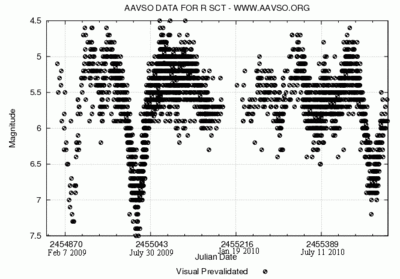R Scuti
| Observation data Epoch J2000 Equinox J2000 | |
|---|---|
| Constellation | Scutum |
| Right ascension | 18h 47m 28.95s[1] |
| Declination | −05° 42′ 18.5″ |
| Apparent magnitude (V) | 4.2—8.6[2][3] (naked eye) |
| Characteristics | |
| Spectral type | G0Iae-K2p(M3)Ibe[2][3] |
| Variable type | RV Tau[2][1] |
| Astrometry | |
| Radial velocity (Rv) | 44.0[1] km/s |
| Parallax (π) | 2.32 ± 0.82[1] mas |
| Distance | approx. 1,400 ly (approx. 400 pc) |
| Absolute magnitude (MV) | -2.6 (@431pc)[4] -3.8(?) (@750pc)[5] |
| Details | |
| Radius | 87.4[4] R☉ |
| Luminosity | 1000[4] 9400 ± 7100[6] L☉ |
| Temperature | 4500[6]—5190[4] K |
| Other designations | |
HD 173819, HIP 92202, 2MASS J18472894-0542185, SAO 142620[1] | |
R Scuti (R Sct) is a star in the constellation of Scutum. It is a yellow supergiant and is a pulsating variable known as a RV Tauri variable.
It was discovered in 1795 by Edward Pigott at a time when only a few variable stars were known to exist.[7] R Sct is the brightest of the RV Tau-type stars[8] and the American Association of Variable Star Observers (AAVSO) contains over 110,000 observations of this star.[7] At its brightest it is visible to the naked eye, and at its dimmest can be located with good binoculars.[7] In the sky it is about 1 degree northwest of the Wild Duck Cluster (Messier 11).[7]
Distance
Hipparcos gives a parallax of 2.32 milli-arcseconds for R Sct,[1] giving it an estimated distance of 431 parsecs (1,410 light-years).[4] But a period–luminosity relation similar to what is used for Cepheid variables suggests that R Sct is at a distance of 750 parsecs (2,400 light-years) with a luminosity of around 9400 Suns.[6] But this would make R Sct twice as luminous as the next most luminous RV Tau-type star in the study.[6] The author of the period–luminosity study doubts the high luminosity and resulting distance, and it has been argued (Matsuura2002) that R Sct is a thermal-pulsing AGB star, observed in a helium-burning phase instead of a post-AGB star.[6] In either case the luminosity is far below the Ia-Ib spectral type would indicate (30,000-100,000 L☉ would be more typical), and R Scuti is clearly in an unusual evolutionary state.

See also
References
- ↑ 1.0 1.1 1.2 1.3 1.4 1.5 "R Scuti". SIMBAD Astronomical Database. Retrieved 2010-11-24.
- ↑ 2.0 2.1 2.2 "GCVS Query=R Sct". General Catalogue of Variable Stars @ Sternberg Astronomical Institute, Moscow, Russia. Retrieved 2010-11-24.
- ↑ 3.0 3.1 "R Sct". AAVSO: Variable Star Plotter (VSP). Retrieved 2010-11-24.
- ↑ 4.0 4.1 4.2 4.3 4.4 "Spectral analysis for the RV Tau star R Sct". NOAO Education & Public Outreach. Retrieved 2010-11-24.
- ↑ absmag "M" = vmag "5.5" + absmag of G2V main sequence star "5" - 5 log (distance)
M=5.5+5-5(log 750)=-3.8 - ↑ 6.0 6.1 6.2 6.3 6.4 Ruyter, S; Winckel; Dominik; Waters; Dejonghe (2005). "Strong dust processing in circumstellar discs around 6 RV Tauri stars. Are dusty RV Tauri stars all binaries?". Astronomy and Astrophysics 435 (1): 161–166. arXiv:astro-ph/0503290v1. Bibcode:2005A&A...435..161D. doi:10.1051/0004-6361:20041989.
- ↑ 7.0 7.1 7.2 7.3 "R Scuti : A Favorite Among Its Class". AAVSO. Retrieved 2010-11-24.
- ↑ "GCVS Type=RV". General Catalogue of Variable Stars @ Sternberg Astronomical Institute, Moscow, Russia. Retrieved 2010-11-24.
External links
- R Scuti on WikiSky: DSS2, SDSS, GALEX, IRAS, Hydrogen α, X-Ray, Astrophoto, Sky Map, Articles and images
- AAVSO: Quick Look View of AAVSO Observations (get recent magnitude estimates for R Sct)
| ||||||||||||||||||||